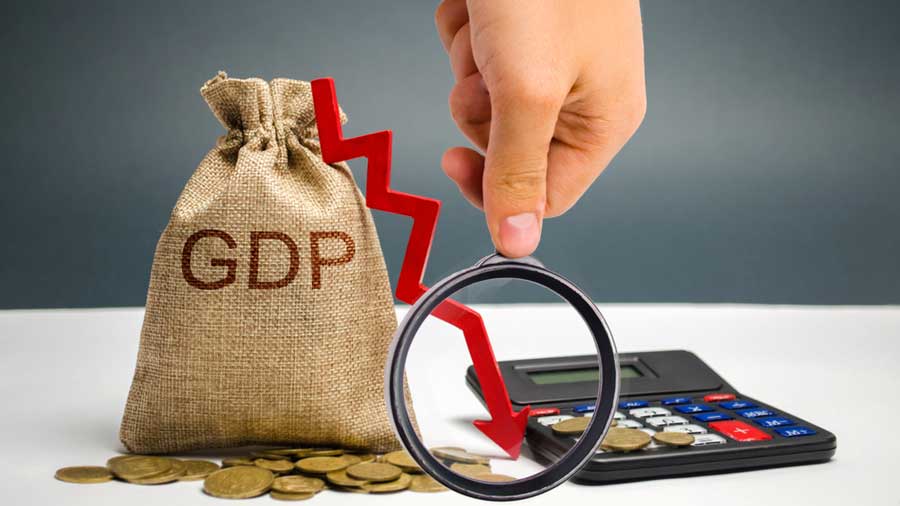India’s pandemic-battered economy grew by a slower-than-expected 5.4 per cent in the third quarter of the financial year, according to new official data. The growth weakness comes as the country faces serious economic risks from Russia’s invasion of Ukraine.
The growth for the three months to December was far below the consensus forecast by economists of 6.0 per cent expansion. Economists believe the final quarter numbers could be even weaker as a result of the impact of the third Covid-19 wave which struck in January. The economy is facing a “drag in manufacturing output and the impact of the Omicron variant,” says ICICI Bank economist Sameer Narang.
The Gross Domestic Product (GDP) figures released late Monday prompted the government to cut its growth forecast for the full year to the end of March to 8.9 per cent from 9.2 per cent. The economy, which was already suffering a deep economic downturn before the pandemic, shrank by 7.3 per cent last year.
Economists said the reasons for the disappointing GDP numbers in the three months from October to December were sharply slowing industrial production and higher inflation. “There is some loss of momentum to revival,” says Brickwork Ratings. “Persistent supply-side bottlenecks, steadily rising international crude oil prices and increasing raw material costs have added to the woes,” the rating agency added.
The slowing growth momentum comes as India faces potentially significant economic fallout at least in the short term from Russia’s invasion of Ukraine. The invasion has driven up commodity prices especially that of crude oil to over $100 in recent days. India imports 80 per cent of its crude oil requirements.
The conflict looks set to seriously upset the government’s recently released budget calculations that projected oil prices of $70-$75 per barrel. The surge in oil prices “poses considerable risks to the Indian economy,” says Bank of Baroda economist Aditi Gupta.
Also, “the decision of Western countries to impose large-scale restrictions and sanctions on Russian banks including the Russian central bank will have widespread short-term repercussions on global inflation, investment and trade and medium-term implications for globalisation and geopolitics," said Kotak Securities.
The growth figures came against the backdrop of consumer price inflation (CPI) which climbed to 5.59 per cent in December. (Latest January figures the CPI has risen to 6.01 per cent, breaching the central bank’s 6.0 per cent tolerance level while wholesale price inflation is running at nearly 13 per cent). Factory output as shown by the IIP or Index of Industrial Production hit a 10-month low of 0.4 per cent in the final month of the year from growth of 3.2 per cent in October.
Private consumption, which accounts for nearly 55 per cent of India’s GDP, remains below pre-pandemic levels amid weak consumer sentiment and the devastating hit to household incomes from Covid-19.
Looking ahead to the final quarter, Brickwork Ratings noted that the rapid spread of Omicron in January led to fresh curbs on economic activities and dampened economic revival. In addition, manufacturing output has been hampered by a semiconductor shortage in the electronics and automobile industries along with supply shortages in coal and power outages. Now, rising international crude oil and input prices as a result of the Ukraine conflict “have added to the problem,” the agency said.
The third-quarter growth of 5.4 per cent contrasts with the 8.4 per cent growth in the second quarter and 20.3 per cent expansion in the first quarter.
Finance Minister Nirmala Sitharaman acknowledged late last week that the country is facing new economic challenges as a result of the Ukraine war. “When value chains are facing challenges and threats because of these disturbances, our recovery, not just for India, but countries everywhere will be severely hampered,” she said,
The worse-than-expected growth data could pile pressure on the struggling currency which is trading at Rs 75.35 to the dollar on the back of the conflict between Russia and Ukraine.
The Reserve Bank of India has kept interest rates low to spur economic growth, lagging its peers globally that have already tightened monetary policy to counter inflation which is a worldwide problem. But if India’s inflation continues to push higher, the central bank may be forced to boost rates, further denting recovery.











